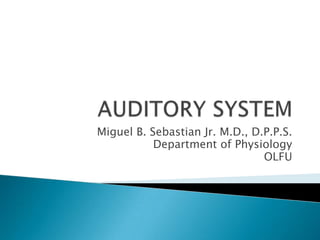
Functions of the Ear and Hearing Process
- 1. Miguel B. Sebastian Jr. M.D., D.P.P.S. Department of Physiology OLFU
- 2. The Human Ear
- 6. Function of the muscles and ossicles Functions ◦ Protects the cochlea from damaging vibrations by excessively loud sounds ◦ Mask low frequency sounds in loud environments ◦ Decrease persons sensitivity to his or her own speech ◦ Latency – 40 to 80 milliseconds ◦ Contraction of tensor tympani and stapedius dampens the movement of ossicles and decreases the sensitivity of acoustic apparatus ◦ Reduces intensity of sound transmission by 30 – 40 dB
- 7. Impedance Matching Device (tympanic membrane and ossicles) Acoustic impedance higher in fluid-filled cochlea than in air Depends on the following ◦ Ratio of the surface area of large tympanic membrane to that of the smaller oval window ◦ Mechanical advantage of the lever system formed by the ossicle chain
- 8. Eustachian tube – equalizes pressure differences between external ear and middle ear Infection: fluid collects in middle ear E.T. blocked pressure differences pain, displacement of the Tympanic Membrane rupture
- 14. Sound ◦ Produced by compression and decompression waves that are transmitted in air or in other elastic media such as water
- 15. Sound Frequency ◦ Measured by cycles per second – hertz (Hz) ◦ Travels more slowly than light Light – 300,000 km/sec (186,000 miles/sec) Sound – 0.331 – 0.334 km/sec (0.2 miles/sec) – at 20 oC at sea level (↑ with temperature and altitude) - 335 m/sec in air (Berne & Levy) Speed of sound: Solid > Liquid > Air
- 16. Sound wave ◦ Expressed as Sound Pressure Level (SPL) ◦ Decibel (dB) ◦ SPL = 20 log P/Pr P= sound pressure Pr = reference pressure (0.0002 dyne/cm2) - the absolute threshold for human hearing at 1000 Hz
- 17. Normal Human Ear ◦ Sensitive to pure tone with frequency of 20 to 20,000 Hz ◦ >100 dB – damage the auditory apparatus ◦ >120 dB – pain and permanent damage * As people age, their threshold at high frequency rises thereby reduces the ability to hear such tone (presbycusis)
- 20. Sound waves cause T.M. to oscillate Oscillations transmitted to the scala vestibuli creates a pressure difference between the S.V. and S.T. displaces the basilar membrane stereocilia of the hair cells bend. Upward displacement bends the stereocilia toward the tallest cilium (away from the modiolus) depolarizes the haircells. Downward deflection – bends the stereocilia away - hyperpolarized
- 22. • apex is wider than the base • tension is higher at the base than at the apex • base vibrate at higher frequency than the apex (frequency analyzer)
- 23. • length of the fibers is greater at the apex than at the base • fiber diameter is greater at the base than at the apex • base -- shorter and wider • apex – taller and slender • high –frequency resonance (base), low frequency resonance (apex)
- 25. Ossicular Conduction ◦ Main pathway for normal hearing Air Conduction ◦ Unimportant for normal hearing ◦ Mediated by vibration of round window Bone Conduction ◦ Involves skull bone ◦ Plays a role in transmission of extremely loud sounds
- 26. Presence of one sound decreases an individual’s ability to hear other sounds Due to the relative and absolute refractoriness of previously stimulated auditory receptors and nerve fibers to other stimuli
- 27. Brodmann’s area 22 ◦ Concerned with the processing of auditory signals related to speech ◦ Right side – melody, pitch and sound intensity Planum Temporale ◦ Portion of posterior superior temporal gyrus ◦ Involved in language-related auditory processing
- 30. Conductive Deafness ◦ Due to impaired sound transmission in external and middle ear ◦ Impacts all sound frequencies ◦ Causes: Plugging of the EAC with cerumen or foreign body Otitis externa and otitis media Perforation of eardrum osteosclerosis
- 31. Sensorineural Deafness ◦ Due to loss of cochlear hair cells ◦ Problems with CN VIII ◦ Lesions within the Central Auditory Pathway ◦ Impairs the ability to hear certain pitches (permanent) ◦ Causes: Aminoglycosides Prolonged exposure to noise Tumors and vascular damage
- 32. Audiometer Tuning Fork
- 34. Thanks!!!